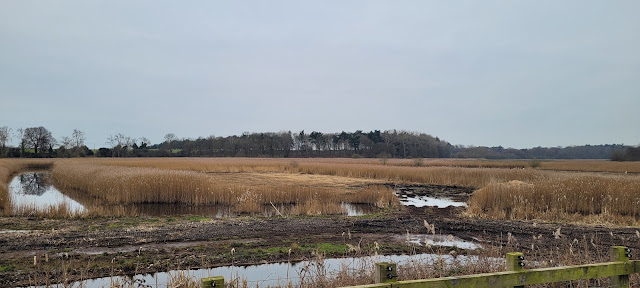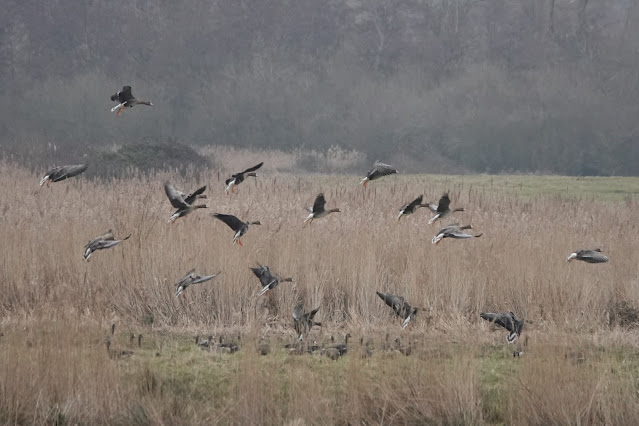Another East Anglian www.blueeyedbirder.com weekend…
A slightly later start saw us convene in The Drive in Reydon
for 8.30 on a flat grey morning but at least the four Waxwings were immediately
on show in the top of the tallest trees from where they periodically flashed
out for an fly. They have been somewhat
sporadic in their appearances since I saw them in late January so it was good
to see them so promptly.
 |
| Waxwings |
Richard had to dash back to his digs in Lowestoft where he
had left his camera batteries so we agreed to meet him just down the road at
Hen Reedbeds.
A party of Siskins greeted our arrival and Chaffinches and
Great Tits were singing while out over the marsh I found a Water Pipit in the
top of a small Willow and had a Grey Wagtail fly over. Reed Buntings were singing across the reedbed
and were the first we had heard this year.
Goldcrest and Cetti’s Warbler foraged in the Brambles below us and a
female Marsh Harrier hunted further back.
We followed the path through the damp woodland finding
Chaffinches, Redwings, Song Thrushes and Blackbirds amongst the leaf litter
while a Brambling flew over calling. Crossing
the road we found that the tide was full out be we had a pleasant enough amble
along the wall. There were even more
Reed Buntings singing but all were just below the top of the Phrag for their
warm up performances. A couple of
Stonechats popped up to hover after prey but despite the calm conditions we
heard no Beardies.
A flock of Curlew spiralled in to join the Lapwings up on
the top field and we could hear Skylarks going strong.
 |
| Curlew |
The mud initially looked devoid of life but a scan revealed
a good number of Lapwing, Oystercatcher, Curlew, Golden Plover, Redshank,
Black-tailed Godwits and Dunlin spread thinly across the mud with the odd Grey
Plover and many Shelduck and Wigeon.
There were more duck in the central channel with Shoveler,
Teal and Gadwall joining the others along with several splendid looking
Cormorants and three Little Grebes.
A Little Egret wiggled its toes in the adjacent pool and
three each of Buzzard and Marsh Harrier were on patrol although I think that we
were the only ones to see the male Peregrine go over as nothing else even twitched!
On south to Westleton Heath where a singing Woodlark greeted
us as we emerged from the cars. That
mournful song will always be one of my favourites. A Dartford Warbler sang a couple of times and
churred too but eluded our eyes and we could hear another Woodlark and
Yellowhammer way off in the distance. It
was eerily still and unlike the yesterday there was barely a bird to be heard.
A third male Woodlark was half singing from a Birch with his prospective mate
sitting a little lower down. They soon took
off and spent the next ten minutes in slow fluttery loops around the clearing
with the male circling around her singing and performing mini parachute flutters
and falls. It was beautiful.
 |
| Woodlarks - the Dance |
 |
| Woodlark - Richard Hanman |
We left them to their nuptials and helped Antony look for
Phyllonorycter ulicicolella mines on fresh Gorse stems which proved successful. The path sides were dotted with thumb sized
holes and excavations and we believe it to be the work of Minotaur Beetles
although we never actually saw one.
 |
| Minotaur burrows |
 |
| Phyllonorycter ulicicolella |
The other side of the road offered us a Goldcrest and Antony
saw a Dartford briefly but it never came out again. With lunch and loos needed we moved on to
Dunwich Beach and plonked ourselves down on the shingle bank. The view out to sea was very peculiar with a rolling
but waveless vista that merged seamlessly into the sky. A dark smudge proved to
be a large raft of Common Scoter and we counted at least 170 which is probably
the most I have seen in Suffolk. A
little further back 16 beefy Velvet Scoters formed their own gang and revealed
the occasional white wing flap. There were odd Scoter dotted around but judging
distance was tricky and so they sometimes looked huge because they were
actually closer! Similarly objects that looked stationary turned out to be
actually flying well above the invisible water. It was all rather odd. Several Cormorants
and Red-throated Divers were the only other birds seen.
 |
| Common Scoter |
A scan of the Dingle Marshes added a brief Great White Egret
and a herd of nine doe and a fine stag Red Deer whose antlers were visible
above the reed tops. Stonechats were
seen flycatching from the reed stems by the cars as we headed off to North
Warren. Thorpeness was rammed and the
prospect of parking in the little free car park seemed remote but as we neared it
I spied a layby on the right and we managed to get all three cars into it. It was perfectly placed with about a hundred Barnacle
Geese immediately opposite with four much larger Canada Geese while a large
gathering of Russian White-fronts could be seen at the back of the marsh.
 |
| Barnacle Geese and one Canada Goose |
We made our way up to the central path and decided to walk
all the way across as we could see what looked like a viewing platform right
next to the White-fronts passing some very smart close Greylags and a good spread
of Pintail and Wigeon on the way through and a Great White Egret lumbered off
towards Aldeburgh giving me my traditional distant shot for the blog.
 |
| Great White Egret |
 |
| Greylags |
The Russian White-fronted Geese had all moved back to the flash just before we
arrived but it did give us the chance to make an accurate count and 197 was the
consensus although may have missed a few.
Within 15 minutes they started to flight and waddle back into the closer
green sward and we spent a fine session watching these dapper geese with their
pink bills, orange legs, white blazes and black belly bars. There were many family groups and frequent
tussles between parents over prime grazing rights and it was good to see
several broods of four and five.
 |
| Look at those fabulous tail patterns! |
 |
| Russian White-fronted Geese |
Pleased with our decision to walk through we retraced our
steps and scanned the marshes once again, this time finding a Spoonbill as well
as the Great White Egret. Rooks and
Jackdaws were ganging up in the fields but I am not sure where the local roost
is for these birds. We were just showing a couple the big white birds when I
glanced up to see a female Goosander whizzing overhead with a gleaming drake in
tow. They ditched on the closest pool
where the male outshone all the other wildfowl around him.
 |
| Koniks |
 |
| Goosander and Pintail |
The light was now fading and it was becoming cooler once
again but there was still time for a look out the south side of Aldeburgh at Slaugden but there
tide was in and the place was thronging with the ‘weekend beautiful people’ so
we had a short walk along towards the Martello Tower seeing chip hunting Turnstones
amongst the Black-headed Gulls while the odd sea was covered in roosting gulls
and another little raft of 22 Scoter, 12 Great Crested Grebes and six
Red-throated Divers. With the light fading we called it a night after a splendid
second day along the coast.
Back at Pakefield (via the moth ridden A12 toilet block) there was the opportunity for some better
shots of the moths from the previous evening before dinner and a g’n’t beckoned.
 |
| I stayed in the car... |
 |
| Pale Brindled Beauty |
 |
| Satellite |
 |
| Spring Usher |
 |
| Spring Usher |






















.JPG)

















No comments:
Post a Comment